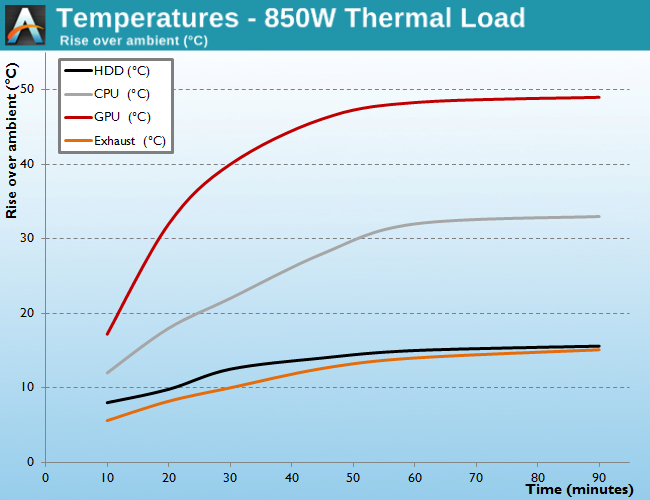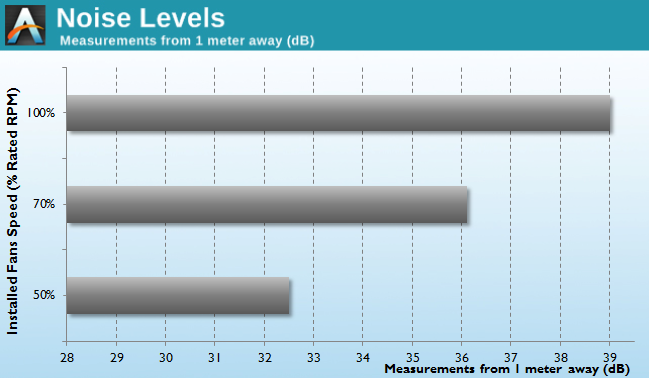Corsair Graphite 760T Case Review
by E. Fylladitakis on March 27, 2014 1:10 PM ESTTest Setup
Professional testing requires the emulation of real-world situations but with repeatable results; thus, a perfectly controllable test setup and environment are required, especially for comparable results. Testing the thermal performance of any case with a typical real-world setup technically limits the comparability of the results to this setup alone, as an active system interacts with its environment and the change of a single component alters (albeit in small ways) myriads of variables. In order to eliminate such factors, we developed synthetic loads that emulate the thermal output of real systems that are passive, steady and quantifiable.
Our thermal testing now displays the thermal capabilities of the case alone, as if it must deal with the entire thermal load by itself, regardless of the system that might be installed inside it. Laboratory data loggers are used to monitor the PT100 sensors and control the safety relays, which are fully accessible via our custom software. Three such loads have been developed, and today we'll be using the ATX load.
The ATX version simulates a 200W CPU, 50W VRM, 30W RAM and 4 × 120W GFX card thermal load; additionally, three 3.5" HDD dummy loads are also present that each convert 30W of electrical power to thermal, bringing the total thermal load of the ATX test setup up to 850W. As such, the thermal load is immense and only the best of cases will be able to handle it for more than a few minutes. We also test with a thermal load of 400W, with all of the aforementioned components except the HDD drives at about 42% power, which is more suitable for the majority of cases.
Thermal testing is performed with all of the case's stock fan operating at maximum speed. Noise testing is performed with a background noise level of 30.4dB(A).The top panel cover remained installed.
Results and Discussion
The thermal performance of the Corsair Graphite 760T is rather good but we cannot really claim that it is great considering the size and nature of the case. The stock cooling fans are not very powerful and ventilation depends on them while the top panel cover remains attached. It performed well enough to compete with mid-tower cases designed for maximum thermal performance, such as the Obsidian 450D, but the Graphite 760T is significantly larger and pricier.
The reduction of the load down to 400 Watts displays that the Graphite 760T has mediocre thermal inertia for a case this size. It appears that the thermal performance of the Graphite 760T heavily depends on the airflow of the cooling fans, at least while the top panel cover remains attached.
Probably due to the nature of the Graphite 760T, virtually no measures have been taken in order to reduce the noise coming from the case. Only the 3.5" devices are decoupled from the chassis; any vibrations from the PSU will be transferred directly to the chassis, as the unit sits on the metallic bottom of the case. The fascia not only is heavily perforated but it also has two 140mm fans directly exposed to the front of the case. The plastic cover of the top panel can block some of the noise but removing it exposes the entire top side of the case as well. As such, the Graphite 760T is definitely not a case specifically designed for silent computing. Nevertheless, the stock fans are not loud at all; they will be clearly audible only at their maximum speed and they reach virtually inaudible levels as soon as their voltage goes below 8V.













71 Comments
View All Comments
Larry Endomorph - Friday, March 28, 2014 - link
You're doing it wrong!Those line charts are useless for us color blind readers.
E.Fyll - Friday, March 28, 2014 - link
Uh, um, I am sorry about that?I cannot use any other type of chart to display several dozens of data points though and I cannot go with black/white line charts either; these would be great for a scientific paper but extremely out of place in an online editorial. However, I am open to suggestions.
scook9 - Friday, March 28, 2014 - link
I would think that in a world where the cheaper and better looking 750d exists this case is 110% unnecessary.....they are the functional equivalent this one is just uglier....and more expensive....Burticus - Friday, March 28, 2014 - link
Pricey! Venturing into Antec P183 pricing here, and I wouldn't put them in the same quality boat. This looks like a $99 case, tops.PEJUman - Friday, March 28, 2014 - link
It's a great idea to run a constant load for the thermal testing. I wonder why it took this long for someone to do it this way. I would also be interested at 1000W load for triple/Quad GPU & dual processors for cases that big enough for it. Although for most cases, 800-400W range is perfect.Some comments:
Can you post the test setup pictures for visualization? maybe schematic of the thermal loads location & temperature measurements.
The gravy on top would be total airflow thru the test, although I understand this one would be quite hard to capture since you would need some single inlet/outlet enclosure big enough to contain the case & some means to measure very low airflow around it (I don't think LFE will be able to measure flow rate this low, and other solutions are quite a bit more money, one can dream I guess...). This would allow some us to roughly scale the case performance with more/less fan(s) if we were to buy and build the said case.
Larry Endomorph - Saturday, March 29, 2014 - link
Add tick marks to the lines. Something like this:http://www.excel-easy.com/examples/images/line-cha...
SkyBum - Saturday, March 29, 2014 - link
In the first screenshot in the article, you can see a rainbow hue in the window panel. My 600T window had the exact same defect, making a large part of my motherboard look quite blurry. Most of the text on the motherboard is impossible to read through the defect. It's like it's blurred into triplicate.I sent screenshots to Corsair and left messages on one of their "support" forums but they never bothered to even reply.
SkyBum - Saturday, March 29, 2014 - link
Oops, first screenshot on the second page was what I meant to say...paul878 - Saturday, March 29, 2014 - link
That's a pretty expensive ugly case.nepenthes - Wednesday, April 2, 2014 - link
When I first saw this case, I thought "Damn, this looks beautiful." Large, see-through (to a degree) side panel that fully opens on a hinge? B&W colour scheme? Convenient, easy to clean dust filters? Space for large radiator setups? Other than the drive bays at the front, which I'm not too keen on, I think it's pretty much the next case I'll be using for my next build.Shame about the price though, there are a lot of cases around that price range it's competing against.